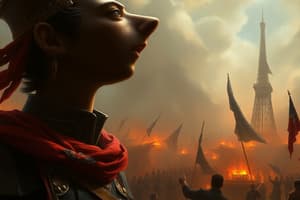Podcast
Questions and Answers
What is the Great Fear?
What is the Great Fear?
A wave of panic that arose within the peasants of the countryside.
Why did the Great Fear happen?
Why did the Great Fear happen?
Because rumors spread that nobles hired gangs to destroy peasants' crops.
What did the peasants do as a result of the Great Fear?
What did the peasants do as a result of the Great Fear?
They armed themselves and destroyed noble homes and feudal records.
Why is the Great Fear significant?
Why is the Great Fear significant?
When did the women's march to Versailles occur?
When did the women's march to Versailles occur?
What did the women marching to Versailles want?
What did the women marching to Versailles want?
How does Louis XVI respond to the marching women?
How does Louis XVI respond to the marching women?
What is the result of the women's march to Versailles?
What is the result of the women's march to Versailles?
What is The Declaration of the Rights of Man and Citizen?
What is The Declaration of the Rights of Man and Citizen?
What are some ideas of The Declaration of the Rights of Man and Citizen?
What are some ideas of The Declaration of the Rights of Man and Citizen?
What is the motto of the French Revolution?
What is the motto of the French Revolution?
When did Marie and Louis try to escape Paris?
When did Marie and Louis try to escape Paris?
Where did Marie and Louis try to escape?
Where did Marie and Louis try to escape?
Why was it bad that Louis and Marie tried to escape?
Why was it bad that Louis and Marie tried to escape?
When was the Constitution of 1791 written?
When was the Constitution of 1791 written?
What did the Constitution of 1791 do?
What did the Constitution of 1791 do?
Name the events that happened during the National Assembly.
Name the events that happened during the National Assembly.
What is the Legislative Assembly?
What is the Legislative Assembly?
What did the Legislative Assembly do?
What did the Legislative Assembly do?
Who were the radicals?
Who were the radicals?
Who were the conservatives?
Who were the conservatives?
Who were the moderates?
Who were the moderates?
Why do Austria and Prussia urge for the restoration of French monarchy?
Why do Austria and Prussia urge for the restoration of French monarchy?
What happens in April 1792?
What happens in April 1792?
How did Prussia attempt to save the French monarchy?
How did Prussia attempt to save the French monarchy?
When was the invasion of the royal palace in Paris and what happened?
When was the invasion of the royal palace in Paris and what happened?
Who was the Paris Commune made of?
Who was the Paris Commune made of?
Who were the Paris radicals?
Who were the Paris radicals?
Who were the sans-culottes?
Who were the sans-culottes?
What were the September Massacres?
What were the September Massacres?
Flashcards are hidden until you start studying
Study Notes
The Great Fear
- A wave of panic among peasants in the countryside during the National Assembly.
- Triggered by rumors of nobles hiring gangs to destroy crops.
Peasant Actions
- Peasants armed themselves and attacked noble homes.
- Destroyed feudal records that tied them to the land.
Significance of the Great Fear
- Marked the unofficial end of feudalism in France.
Women's March to Versailles
- Occurred on October 5th, 1789.
- Women demanded bread and the return of the king and queen to Paris.
King Louis XVI's Response
- He refused to meet with the marching women.
Outcomes of the March
- Resulted in the king and queen returning to Paris, effectively under house arrest.
The Declaration of the Rights of Man and Citizen
- A document outlining Enlightenment ideals.
- Key principles included:
- Equality of men and rights from birth.
- Fundamental rights to life, liberty, security, and resistance to oppression.
- Equal justice and freedom of speech and religion.
Revolution Motto
- "Liberty, equality, fraternity" became the revolutionary motto.
Attempted Escape of Louis XVI and Marie Antoinette
- Attempted to flee Paris in June 1791.
- Aimed for escape to Austria.
- Their capture led to significant loss of public support.
Constitution of 1791
- Written in September 1791 by the National Assembly.
- Established a limited monarchy and a new legislative body.
Events During the National Assembly
- Great Fear
- Women's march on Versailles
- Declaration of the Rights of Man and Citizen
- Royal escape attempt
- Adoption of the Constitution of 1791
- Storming of the Bastille
Legislative Assembly
- The second regime of the Revolution, following the National Assembly.
- Responsible for creating laws and declaring war.
Political Groups in the Legislative Assembly
- Radicals: Left-wing members opposing monarchy, seeking significant change.
- Conservatives: Right-wing members supporting limited monarchy, preferring pre-Revolution conditions with minimal changes.
- Moderates: Centrists advocating for a balanced amount of change; held the most influence.
International Concerns
- Austria and Prussia aimed to restore French monarchy due to fears of revolutionary effects in their own nations.
War Declaration
- In April 1792, the Legislative Assembly declared war on Austria.
Prussian Threat
- Prussia gathered forces near Paris, threatening destruction if royals were harmed.
Invasion of the Royal Palace
- Occurred on August 10th, 1792, when 20,000 men stormed the palace.
- Sparked by rumors of royal collusion with Austrians; royal family was arrested.
Paris Commune Composition
- Formed by Paris radicals and sans-culottes.
Paris Radicals
- Violent group that took the king captive, advocating for universal male suffrage.
Sans-Culottes
- Working-class individuals seeking extensive reforms, exerting pressure on the monarchy.
September Massacres
- Citizens raided prisons due to fears of royal supporters escaping and taking control, leading to a large number of deaths.
Studying That Suits You
Use AI to generate personalized quizzes and flashcards to suit your learning preferences.





